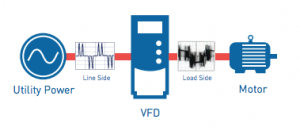Variable Frequency Drive Effects With MTE Solutions
Variable Frequency Drive Effects With MTE Solutions
“Across the Line” Motor Application… Why VFDs Are Needed When a motor runs directly from the power source, it is said to be running “across the line”. In this approach, there are uniform, sinusoidal current and voltage waveforms and relatively few power quality concerns.

Unfortunately, this method is significantly inefficient because the motor is continuously running at its top speed, regardless of the requirements placed on it by the load. The application uses the energy it needs, and the rest of the energy is wasted.
VFDs Add Efficiency… But Create Power Quality Issues Adding a VFD to electrically control motor speed increases efficiency by limiting energy consumption and reducing equipment wear. However, VFDs inadvertently create power quality issues in the form of harmonics, which are changes or distortions in the waveforms. There are different types of harmonic distortions on the line and load side of a VFD.

On the line side, harmonics are created because the incoming side of a standard six-pulse VFD does not draw current linearly. Instead, it pulls in six distinct pulses that each use some of the current and send the unused portion back to the source as current harmonics. Since current and voltage are proportional, current harmonics ultimately affect voltage, which impacts connected equipment. This is not only a problem for equipment in the same facility as the offender, but for any consumer who shares a connection to the facility. On the load side, the VFD does not feed the motor a true voltage waveform, but rather series of electrical pulses in a pattern that replicates an AC sinewave. This is called pulsewidth modulation (PWM) and although it is effective at precisely controlling motor speed, it creates harmonics that can damage motors, cables and bearings. The problems are magnified if the physical distance between the VFD and motor is long.

